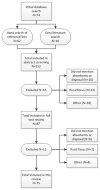Menstrual Hygiene Management and Waste Disposal in Low and Middle Income Countries-A Review of the Literature - PubMed (original) (raw)
Review
Menstrual Hygiene Management and Waste Disposal in Low and Middle Income Countries-A Review of the Literature
Myles F Elledge et al. Int J Environ Res Public Health. 2018.
Abstract
Menstrual hygiene management (MHM) has gained some attention and several literature reviews have been published. However, both original papers and reviews tend to focus on absorbent access and use and not on the disposal of menstrual waste. This review aims to fill a gap in the water, sanitation and hygiene (WASH) sector by bringing a focus specifically on menstrual hygiene safe disposal in low- and middle-income countries (LMIC). We reviewed published literature since 2002 on menstrual hygiene with a focus on menstrual waste management and menstrual absorbent disposal in LMIC. Database searches were conducted of both peer reviewed literature and grey literature, in addition to hand searching of references of relevant earlier literature reviews. In total 152 articles and reports were identified and 75 met the inclusion criteria and was included in the final review. Existing polices on MHM was also reviewed with a focus on India and South Africa. The review showed that disposal of menstrual waste is often neglected MHM and sanitation value chains, leading to improper disposal and negative impacts on users, the sanitation systems and the environment. Findings call for further research to gain better understandings of MHM waste streams, disposal behaviors, absorbent materials and waste management technologies to deliver health, safety, mobility and dignity for women and girls.
Keywords: environmental health; gender; menstrual hygiene management; menstrual hygiene waste disposal; sanitary waste; water and sanitation.
Conflict of interest statement
The authors have no conflicts of interest.
Figures
Figure 1
Inclusion/Exclusion Criteria for Literature Review.
Figure 2
Literature Search Process Flow.
Figure 3
LMICs Country & Regions for Articles Reviewed on Menstrual Absorbents.
Figure 4
Waste disposal pathways and potential environmental and health hazards.
Similar articles
- Menstrual hygiene management in rural schools of Zambia: a descriptive study of knowledge, experiences and challenges faced by schoolgirls.
Chinyama J, Chipungu J, Rudd C, Mwale M, Verstraete L, Sikamo C, Mutale W, Chilengi R, Sharma A. Chinyama J, et al. BMC Public Health. 2019 Jan 5;19(1):16. doi: 10.1186/s12889-018-6360-2. BMC Public Health. 2019. PMID: 30611223 Free PMC article. - A systematic review of menstrual hygiene management (MHM) during humanitarian crises and/or emergencies in low- and middle-income countries.
Patel K, Panda N, Sahoo KC, Saxena S, Chouhan NS, Singh P, Ghosh U, Panda B. Patel K, et al. Front Public Health. 2022 Sep 28;10:1018092. doi: 10.3389/fpubh.2022.1018092. eCollection 2022. Front Public Health. 2022. PMID: 36249215 Free PMC article. - Menstrual hygiene practice among adolescent girls in Ethiopia: A systematic review and meta-analysis.
Sahiledengle B, Atlaw D, Kumie A, Tekalegn Y, Woldeyohannes D, Agho KE. Sahiledengle B, et al. PLoS One. 2022 Jan 4;17(1):e0262295. doi: 10.1371/journal.pone.0262295. eCollection 2022. PLoS One. 2022. PMID: 34982805 Free PMC article. - Menstrual Hygiene, Management, and Waste Disposal: Practices and Challenges Faced by Girls/Women of Developing Countries.
Kaur R, Kaur K, Kaur R. Kaur R, et al. J Environ Public Health. 2018 Feb 20;2018:1730964. doi: 10.1155/2018/1730964. eCollection 2018. J Environ Public Health. 2018. PMID: 29675047 Free PMC article. Review. - Improving menstrual hygiene management in emergency contexts: literature review of current perspectives.
VanLeeuwen C, Torondel B. VanLeeuwen C, et al. Int J Womens Health. 2018 Apr 10;10:169-186. doi: 10.2147/IJWH.S135587. eCollection 2018. Int J Womens Health. 2018. PMID: 29692636 Free PMC article. Review.
Cited by
- "We pray for the night to be shorter, so we can change our menstrual pads": A qualitative exploration of menstrual hygiene challenges among internally displaced adolescent girls in Northern Ethiopia, 2023.
Betsu BD, Medhanyie AA, Gebrehiwet TG, Lewis Wall L. Betsu BD, et al. PLoS One. 2024 Oct 22;19(10):e0309985. doi: 10.1371/journal.pone.0309985. eCollection 2024. PLoS One. 2024. PMID: 39436894 Free PMC article. - Cross-national variation in the prevalence and correlates of current use of reusable menstrual materials: Analysis of 42 cross-sectional surveys in low-income, lower-middle-income, and upper-middle-income countries.
Roy N, Amin MB, Aktarujjaman M, Hossain E, Mugo C, Islam F, Mamun MA, Kumar M. Roy N, et al. PLoS One. 2024 Oct 7;19(10):e0310451. doi: 10.1371/journal.pone.0310451. eCollection 2024. PLoS One. 2024. PMID: 39374244 Free PMC article. - WASH services and menstrual hygiene management among reproductive age females in the IDPs camps of Shire town in Tigray region of Ethiopia: a cross- sectional study.
Tesfay E, Redae GH, Goitom G, Asgedom AA. Tesfay E, et al. Sci Rep. 2024 Sep 30;14(1):22730. doi: 10.1038/s41598-024-73896-6. Sci Rep. 2024. PMID: 39349761 Free PMC article. - Promoting menstrual health and hygiene-insights from the 2023 World Menstrual Hygiene Day celebration events in the Hohoe municipality in Ghana.
Gbogbo S, Wuresah I, Addo P, Klomegah S, Gbogbo E, Axame W, Klutse P, Makam C, Dowou RK, Nelson PE, Boateng I, Mantey SO, Kugbey N, Doku VCK, Hennegan J, Baiden FE, Aziato L, Binka FN. Gbogbo S, et al. Front Public Health. 2024 Sep 13;12:1406665. doi: 10.3389/fpubh.2024.1406665. eCollection 2024. Front Public Health. 2024. PMID: 39346585 Free PMC article. - Development and validation of a survey instrument for reusable sanitary products toward sustainable menstrual hygiene.
Kolil VK, Achuthan K. Kolil VK, et al. Sci Rep. 2024 Sep 27;14(1):22062. doi: 10.1038/s41598-024-72122-7. Sci Rep. 2024. PMID: 39333251 Free PMC article.
References
- Tilley E., Bieri S., Kohler P. Sanitation in developing countries: A review through a gender lens. J. Water Sanit. Hyg. Dev. 2013;3:298–314. doi: 10.2166/washdev.2013.090. - DOI
- Swedish International Development Cooperation (SSIDC) Menstrual Hygiene Management. Agency SSIDC; Stockholm, Sweden: 2016.
- House S. Menstrual Hygiene Matters: A Resource for Improving Menstrual Hygiene around the World. 2012. [(accessed on 4 September 2018)]. p. 347. WaterAid Report. Available online: http://www.wateraid.org/what-we-do/our-approach/research-and-publication....
Publication types
MeSH terms
LinkOut - more resources
Full Text Sources
Miscellaneous



